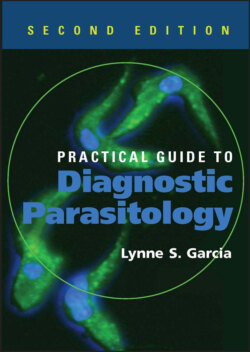Читать книгу Practical Guide to Diagnostic Parasitology - Lynne Shore Garcia - Страница 47
На сайте Литреса книга снята с продажи.
SECTION 2 Parasite Classification and Relevant Body Sites
ОглавлениеAlthough common names are often used to describe parasites and parasitic infections, these names may refer to different parasites in different parts of the world. To eliminate these problems, a binomial system of nomenclature is used in which the scientific name consists of the genus and species.
Based on life cycles and organism morphology, classification systems have been developed to indicate the relationship among the various parasite species. Closely related species are placed in the same genus, related genera are placed in the same family, related families are placed in the same order, related orders are placed in the same class, and related classes are placed in the same phylum, one of the major categories in the animal kingdom. As one moves up the classification schema, each category becomes more broad; however, each category still has characteristics in common.
Parasites of humans are classified in six major divisions (Table 2.1). These include the Protozoa (amebae, flagellates, ciliates, sporozoans, coccidia, and microsporidia), the Nematoda or roundworms, the Platyhelminthes or flatworms (cestodes, trematodes), the Pentastomids or tongue worms, the Acanthocephala or thorny-headed worms, and the Arthropoda (insects, spiders, mites, ticks, and so on). Although these categories appear to be clearly defined, there may be confusion in attempting to classify parasites, often due to the lack of known specimens. If organisms recovered from humans are very rare, it is difficult to determine their correct taxonomic positions. Type specimens must be deposited for study before a legitimate species name can be given. Also, even when certain parasites are numerous, they may represent strains or races of the same species with slightly different characteristics.
Reproductive mechanisms have been used as a basis for determining species definitions, but there are many exceptions within parasite groups. Another difficulty in species recognition is the ability and tendency of the organisms to alter their morphologic forms according to age, host, or nutrition, which often results in several names for the same organism. An additional problem involves alternation of parasitic and free-living phases in the life cycle; these organisms may be very different and difficult to recognize as belonging to the same species. However, newer molecular methods of grouping organisms have often confirmed taxonomic conclusions reached hundreds of years earlier by experienced taxonomists. As studies in parasitic genetics, immunology, and biochemistry continue, the species designation will be defined more clearly by highly sophisticated molecular techniques.
No attempt has been made to include every possible organism; only those that are considered to be clinically relevant in the context of human parasitology are addressed. Some human infections are represented by very few cases; however, they are well documented and are included here. Further information is provided in the tables at the end of this section.
